Domestic violence: A grim legacy spanning generations

Over the years, deeply rooted patriarchal beliefs normalised domestic abuse, paving the way for acceptance of violence against women.
What you need to know:
- The intergenerational culturalisation of domestic violence as an acceptable behaviour was not just a Kenyan thing in the pre-colonial era.
- Domestic violence was like a torch shining the way for households, giving women the impression that it was a necessity they would not live without.
- Jennifer* who got married in 1957, lived through domestic abuse..
- Years later, her son Eric* faced a similar experience.
This story was produced in partnership with Pulitzer Centre.
On the warm mid-morning of July 7, 1957, Jennifer* then aged 16, was busy threshing finger millet with a wooden staff.
From her kneeling position on the goat’s skin, she would see visitors entering their home in Ting’a, a rustic village in the now Nyamira County, lying on the South Western part of Kenya, an East African country.
“I saw my elder sister who was married in Gesiaga (another village in Nyamira County), lead a man in an oversized grey suit into our home. He was tall and handsome, but older than me,” recalls Jennifer.
As she greeted the man, whom she later discovered was 11 years her senior, she heard her sister tell him “This is the one.”
“I didn’t know what she meant. I continued with my work while he conversed with my parents. Suddenly, my mother called me. I thought they were going to introduce me to my sister’s husband as I had never met him before,” the mnemonist octogenarian recounts the moment like it was yesterday.
“My father then told me, the man before me is rich and works in Mombasa. He has come to collect his wife.”
Jennifer was the wife he had come for.
“I didn’t protest. I was somehow happy. I had dropped out of school in Class Two. There was nothing else for me other than getting married. Life at home was not exciting either. We’d survive on porridge after a long day of farm work or post-harvesting work.”
A river separated their home from her husband’s village in Gesiaga. So, they walked back together with her elder sister. She and her sister were barefooted, while her new husband wore black shoes, a distinction implying the haves and have nots.
Her mother-in-law was happy to receive her. She says she treated her like her blood daughter and during their conversations, she could warn her that her son was a hothead, an attribute that ran in their family. His father and grandfather behaved the same way, she informed her.
“She told me her husband would beat her up if he felt she had wronged him,” she says.
“She would say: ‘You know we were married young and maybe you can wrong your husband without knowing. It’s okay if he disciplines you like a father can discipline his daughter.’ ”
There was no honeymoon for her. On the day of arrival, her husband, who later paid dowry, showed her his property that she was to look after. He was the third born of eight children in their family, and the last of five brothers.
“He had many cows and goats, which he had inherited from his later father. He also had a huge piece of land. My work was to take care of his livestock and farm. That didn’t bother me as I was already accustomed to the work. At least here, there was a lot of food and milk. Not like in my home,” tells Jennifer in all honesty.
A week later, her husband left for Mombasa, which at the time was the capital of British East Africa. Jennifer says he told her he worked as a clerk at the port of Mombasa. Since there were no means of communication as then mobile phones were non-existent, she would wait for him to visit from time to time.
All was well until they had their first child in September, 1959.
“I'd be breastfeeding, or serving him food when he would suddenly become angry and threaten to kill me and the baby. Sometimes, he would point a knife at me, saying ‘I will kill you.’ or chase me with a panga. He often did this at night. So, I’d run and hide in a block of bricks in the compound or in the tea bushes,” she says.
“Other times, he caught me and beat me with whatever his hands would get hold of. This went on throughout the years. My mother-in-law would tell me to persevere as she had, and that as women, we were expected to accept some punishment from our husbands and keep the secrets of the family. She told me such punishment was a family matter and, I’d disgrace myself if I told my mother or anyone outside the family.”
This intergenerational culturalisation of domestic violence as an acceptable behaviour was not just a Kenyan thing in the pre-colonial era.
Kenya was like a section of the global community manifesting the absurd obsession to exercise power and control over women, a practice later identified by feminists as “patriarchy.”
This practice was like a torch shining the way for households, giving women the impression that it was a necessity they would not live without, hence accepting it without the option of asking the model of the torch or how it’s powered.
Historians trace the word patriarchy to the Greek compound word patriarkhēs. It’s composed of patria meaning lineage, patērforfather and arkhē which refers to domination. In literal terms, patriarkhēs, a father dominating a lineage.
As documented by anthropologists and sociologists, the term is said to have been historically used to describe autocratic rule by a man as the head of the family.But from the late 20th Century, feminists used it to refer to social systems in which power rests in the hands of men. The theory that patriarchy originated from early agriculture in the 8000-3000 BC period, is widely disputed, especially considering that anthropologists have identified at least 160 existing matrilineal societies across the Americas, Africa, and Asia. The argument is that they used their physical strength to yield a surplus produce and keep cattle, thus deriving their superiority from the huge wealth they had over women.
This inequality can be reflected in Jennifer’s case. At 16 years, she was married with absolutely nothing of her own. Yet, her husband, then 27 years old, had a flock of cows and goats, in addition to a tract of arable land. With no property and tolerant culture, condoning violence becomes the norm, for the wives.
“Return home? To whose land? My mother was tough, I think she would have chased me away. Never ever did I have such thoughts (of returning home),” she says.
“Well, I was in charge of my husband’s property, and what I was going through was a family matter just like my mother-in-law had told me. And my elder sister who brought my husband, mocked me when I confided in her. In any case, my husband was only around a few times. So, it wasn’t a big deal.”
What's domestic violence?
United Nations defines domestic violence also known as intimate partner violence as a pattern of behaviour in any relationship that is used to gain or maintain power and control over an intimate partner.
It can be physical, sexual, emotional, financial or economic, and psychological.
Physical violence
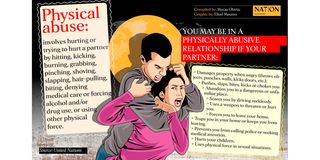
A type of violence that leaves an intimate partner with scars that forever remain a reminder of the pains of domestic violence.
Sexual violence
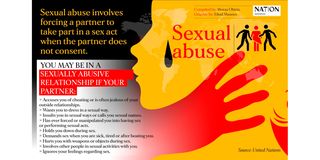
This is a horrible kind of violence and without proper therapy, one can easily fall into depression or commit suicide.
Emotional violence
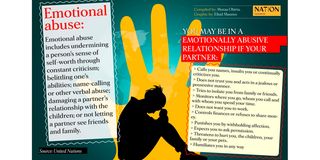
Ever found yourself in a situation where you cannot receive calls from a friend because your spouse does not approve of them? That’s emotional violence.
Financial and psychological violence
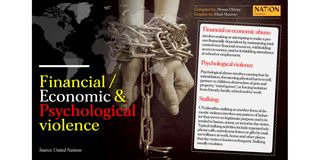
Has your partner refused to allow you to take up a promotion at your workplace because he or she feels you’ll not have time for them? Or threatened to leave you if you did. That is financial and psychological violence.
By the time Jennifer was married, the global community had become cautious of the patriarchy and the violence meted out on women. Efforts were being made to turn public conversations on gender based violence (GBV), and break the grip of inequalities that fuelled the violence. Domestic violence is one form of GBV.
In the 1940s, countries in the Global North had started the push for women’s rights. With the launch of the Commission on the Status of Women in 1946, lobbying through the United Nations mechanism officially began.
However, none of the 15 countries constituting the entity was from Africa, although by the time of its creation, four countries had gained independence namely Liberia, South Africa, Egypt and Ethiopia.
The representative Member States were drawn from the continents of South America, North America, Europe, Oceania, Asia and Antarctica.
But it took 33 years of negotiations, consultations and lobbying for the Convention on the Elimination of All Forms of Discrimination against Women (Cedaw) to be born. By the time the treaty, which affirms women’s human rights, especially freedom from any form of violence, was adopted on December 18, 1979, Kenya was a teenager, spreading her political wings in her 16th year of independence.
Even in Britain, the country that colonised Kenya in 1920 after putting it under its East Africa protectorate from 1895, women were deemed children and it was acceptable of the husbands to punish them for “misdemeanour.”
This perception is reflected in the laws passed by aristocratic men during the 1837-1901 reign of Queen Victoria, addressing some elements of domestic violence. Laws, later exported to Kenya.
Worse violations
For example, the Divorce Act of 1857, allowed a man to successfully file for a divorce on grounds of simple adultery. For a woman, it would require proof of worse violations including violence. The Married Women’s Property Act 1870, allowed women in both Kenya and Britain, to legally own land or house separately under their own name, but they would not rent out the property or sell them without the husband’s consent, a touchpoint for sparking domestic violence.
The roots holding the trees of domestic violence began to wobble in Kenya in the late 1980s thanks to ratification of Cedaw and emergence of women's rights organisations.
Although Mandeleo ya Wanawake had existed since 1952, it primarily focused on lifting rural women out of poverty through agricultural activities, giving little attention to the issue of domestic violence. At the time, the group founded by European women, was the only women’s rights outfit catching the eye of President Daniel Moi, who ruled Kenya from 1978 to 2002.
“During that time (colonial and post-colonial period) the struggle was for civil and political rights,” says Gilbert Onyango, executive director of East African Centre for Human Rights.
“It’s only after 1985 that organisations vocal on ending violence against women emerged. The treaty and the conference provided a solid framework for strongly advocating for the rights of women.”’
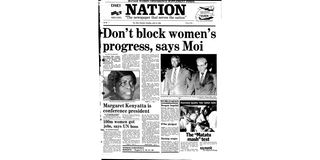
In 1985, Kenya became the third country in the world and the first in Africa to host the third world conference on women in Nairobi, a year after ratifying Cedaw. A gathering that fired up professional women to unite and save women from the indignity of violence.
In the same year, women lawyers came together to form the Federation of Women Lawyers in Kenya (Fida-Kenya), to specifically offer free legal aid to women who had become victims of domestic violence. They also raised awareness through community gatherings.
“In 1985, there wasn’t much awareness about domestic violence and the environment didn’t allow the women and girls to speak out,” says Anne Ireri, who has served as Fida-Kenya executive director since September, 2019.
“We started to facilitate conversations on violence against women to enable the society accept that there is domestic violence and we need to address it,” she says.
However, there was neither a law on domestic violence nor did the 1963 independence Constitution recognise discrimination on the basis of gender, only prohibiting inhuman treatment of any person.
In response, Fida-Kenya activated calls for legal reforms, which extended to inclusion of women in political and public service leadership.
“We started legal advocacy that women’s rights are human rights, and over the years we have seen changes in the legal and policy frameworks,” she points out.

In 1992, President Moi elected Nyiva Mwendwa to his cabinet serving as Minister for Culture and Social Services, an encouragement that their voices were not falling on deaf ears.
Although her ministry was not expressly mandated to lead anti-GBV campaigns, Nyiva carried the mantle and led women in calling for an end to violence against women. When I called her to expound on her work during the time, she just said, she didn't have much to tell me.
Chryspin Afifu, a gender and women's economic empowerment specialist with more than 15 years of experience, remembers the post-1985 women rights movements generally focused on GBV as a whole, and not domestic violence in particular.
“They were anchored on the messaging ‘men stop battering women.’ There wasn’t talk about men being battered by their wives. And there were no laws on domestic violence. And again, domestic violence was considered a private family matter,” he says.
Catherine Mumma, a lawyer and nominated Senator says murmurs about combating violence against women became louder in the 1990s, when there was a concerted effort to have more women take up elective seats.
“Of course, there was no political goodwill to front these issues (domestic violence) but with the multi-party political system, there was a push for women to get into Parliament,” she says.
“But then there were questions of barriers preventing women from actively participating in politics. Domestic violence was one of them. This brought up discussions of what can be done about it,” she says.
With the multi-party system, Ford-Asili, Democratic Party and Ford-Kenya, joined the lot, competing for seats with the ruling party, Kanu. To women, the additional parties increased their paths to elective politics.
In the fiery spirit of wanting to get the message to the people and convince them to protect women, came the challenge of finances.
“There was little donor funding to support women's rights organisation. So, their coverage was really limited,” notes Afifu.
Yet, consistent drives to create awareness were needed at the grassroots.
Until 2002, Jennifer had never heard of people publicly talk about domestic violence let alone speaking out against it.
“I never attended any meeting where people talked about domestic violence. The first time I heard women talk about it in the open was at a tea buying centre in 2002,” she says.
“The police had come to arrest a woman who had hit her husband with a jembe on the head. They said he had used all the returns from tea, yet he never set foot in the farm.”
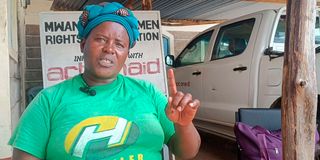
Mary Makau, the organising secretary of Embu-based Mwangaza Women Rights Organisation when she spoke to Nation.Africa on February 26, 2024 at Makima in Mbeere South, in Kenya's Eastern region county of Embu.
For Mary Makau, from Embu, the gospel took even longer to reach their villages. Married in 1996, she grew up seeing her father batter her mother mercilessly and she never left. They would scream and no one would come to her rescue because “the husband was just disciplining his wife and it was improper to intervene.”
“During our time, you were satisfied to find a man who had livestock. You’d count yourself the lucky one to marry a wealthy man, and there was nothing else to think about. Just taking care of the livestock,” explains the 52-year-old Mary.
“And once you were married. That was it. Nothing of yours was left behind for you to go back to. You were only allowed to visit your parents and return to your matrimonial home. Not to return because you have been battered or violated in any way” adds Mary, who completed high school in 1993, scoring a C plain.
During their marriage, her husband, who had dropped out of high school, restrained her from doing business, on grounds that she would turn into a prostitute. She didn't know her husband acted against her human rights until she attended the first women empowerment gathering in her matrimonial village of Makima in 2010, convened by an international non-governmental organisation.
Husbands too, suffered at the hands of their wives
Jennifer’s son, Eric*, a business executive in the capital Nairobi says discussions on domestic violence were more concentrated in Nairobi, and “no one talked about men.”
“We had this joke that ‘Ask a woman you want to marry if she knows Fida. If she tells you, yes, just ‘ruuuuun’ and never look back’,” he bursts out laughing.
He suffered stalking, physical and emotional abuse at the hands of his first wife in the 1990s, leading to their divorce in 1998.
“That woman was a terrorist,” he says in a vocalised tone.
“I was employed at an American company as an accountant and we’d work till late at night. She would come to the office to ask my colleagues if I had a sexual partner in the office. It was so humiliating. Worst of all, I wouldn't ask her. She was this hot-tempered person who would throw anything at you. I was stressed. I couldn't concentrate at work anymore. I finally resigned,” he shares.
End of the job opened another door for hellish treatment.
“At home, I saw hell. Before I got another job, she would lock all the food in the bedroom, leaving behind only the food for the kids. Then, she was one of the few women in corporate leadership,” he says.
The only person he opened up to was a woman friend whom he ended up marrying.
“My wife is one of the renowned women lawyers in Kenya and well she was at Fida, and yes, I didn’t run,” he brags before he unleashes a delightful laughter.
“I’m happy. As to why I stayed that long in that abusive marriage, I don't know. I always think she bewitched me,” he says.
Eric holds that campaigns held at the time “discriminated against men, and until now, they do.”
Mainstreaming domestic violence
It took nearly two decades for the government to mainstream domestic violence. In the years 1989, 1993 and 1998, Kenya released data on its survey of the health and demographic status of its population. None had figures or reference to domestic violence until 2003.
In that year’s Kenya Demographic and Health Survey report, the government recognised that domestic violence does cause “great physical harm, death, psychological abuse, separation, divorce, and a host of other social ills.”
In response, in 2003, the government enacted the National Commission on Gender and Development Act, to facilitate coordination and mainstreaming of gender concerns in national development. Two years earlier, the Children Act had been passed, a law that warranted care and protection for children exposed to domestic violence.
As of 2003, the survey established that 31 per cent of married women in the ages of 15-49 had experienced domestic violence in the past 12 months.
Wives in the rural areas were at a higher risk of violence recording a 27.3 per cent prevalence rate compared to 18.1 per cent for those in the urban.
The survey also found that uneducated husbands and those who had reached high school and beyond were at the highest risk of being abused by their wives.
In the survey, 3.1 per cent of women married to husbands with no education said they had abused them. While 2.5 per cent of the wives admitted to having committed violence against their husbands with a secondary school education or post-secondary training.
Comparably, 2.3 per cent of the wives abused their husbands who dropped out of primary school. And 1.1 per cent did the same to their spouses who had completed primary school.
Over the years, the prevalence worsened.
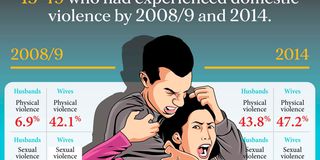
And men are increasingly becoming victims of domestic violence.
Violence against husbands
Times are changing, technology is here with us and demands of life are on another level. Has this caused any shift in the fight against domestic violence in the modern-era?
We'll seek to find out in the next article on domestic violence.
Meanwhile, Jennifer says: “Those days a marriage was like being sent to a prison in a desert. If you escaped you'd probably die trekking to nowhere. Nowadays, there is help. People have mobile phones; you can call the chief or village elder to rescue you.”
Nevertheless, one thing for sure is addressing domestic violence goes beyond balancing gender power relations to tackling men’s and women's mental illnesses.
“My lastborn son was recently diagnosed with bipolar disorder and he exhibited exactly the same symptoms as his father. When he is on the extreme, he chases his wife away. Now I know what was ailing my husband. He died in 2010,” says Jennifer.
What if Eric’s ex-wife had a mental health condition too?




